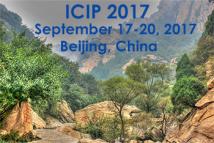
The International Conference on Image Processing (ICIP), sponsored by the IEEE Signal Processing Society, is the premier forum for the presentation of technological advances and research results in the fields of theoretical, experimental, and applied image and video processing. ICIP has been held annually since 1994, brings together leading engineers and scientists in image and video processing from around the world. Visit website.
- Read more about HIGH-ORDER LOCAL NORMAL DERIVATIVE PATTERN (LNDP) FOR 3D FACE RECOGNITION
- Log in to post comments
This paper proposes a novel descriptor based on the local derivative
pattern (LDP) for 3D face recognition. Compared to the local binary
pattern (LBP), LDP can capture more detailed information by encoding
directional pattern features. It is based on the local derivative
variations that extract high-order local information. We propose a
novel discriminative facial shape descriptor, local normal derivative
pattern (LNDP) that extracts LDP from the surface normal. Using
surface normal, the orientation of a surface at each point is determined
- Categories:
 19 Views
19 Views- Read more about ArtGAN: Artworks Synthesis with Conditional Categorical GANs
- Log in to post comments
This paper proposes an extension to the Generative Adversarial Networks (GANs), namely as ARTGAN to synthetically generate more challenging and complex images such as artwork that have abstract characteristics. This is in contrast to most of the current solutions that focused on generating natural images such as room interiors, birds, flowers
- Categories:
 22 Views
22 Views- Read more about STROMULE BRANCH TIP DETECTION BASED ON ACCURATE CELL IMAGE SEGMENTATION
- Log in to post comments
Based on the dynamic structure, we design a system that can perform accurate stromule image segmentation, branch tip detection and tracking automatically. We substitute the user constraints in active contour segmentation by spatial fuzzy c-means clustering for providing more precise segmentation result. Based on the segmented contour after smoothing, we create a surface normal based feature that can accurately detect
the branch tips. We further combine normal information together with tip position coordinate to apply ICP to track the branch tips moving path.
- Categories:
 13 Views
13 Views- Read more about RETHINKING THE HIGH CAPACITY 3D STEGANOGRAPHY: INCREASING ITS RESISTANCE TO STEGANALYSIS
- Log in to post comments
3D steganography is used in order to embed or hide information into 3D objects without causing visible or machine detectable modifications. In this paper we rethink about a high capacity 3D steganography based on the Hamiltonian path quantization, and increase its resistance to steganalysis. We analyze the parameters that may influence the distortion of a 3D shape as well as the resistance of the steganography to 3D steganalysis. According to the experimental results, the proposed high capacity 3D steganographic method has an increased resistance to steganalysis.
- Categories:
 2 Views
2 Views- Read more about HGO-CNN: HYBRID GENERIC-ORGAN CONVOLUTIONAL NEURAL NETWORK FOR MULTI-ORGAN PLANT CLASSIFICATION
- Log in to post comments
Classification of plants based on a multi-organ approach is very challenging. Although additional data provides more information that might help to disambiguate between species, the variability in shape and appearance in plant organs also raises the degree of complexity of the problem. Existing approaches focus mainly on generic features for species classification, disregarding the features representing the organs. In fact, plants are complex entities sustained by a number of organ systems.
HGO-CNN.pdf
- Categories:
 15 Views
15 ViewsThis work addresses image recovery problem in the presence of salt-and-pepper noise and image blur. The salt-and-pepper noise reviewed as the impulsive noise, in this paper, is modeled as a sparse signal because of its impulsiveness. To accurately reconstruct the clean image and the blur kernel, the framelet domains are exploited to sparsely represent the image and the blur kernel. From the reformulations conducted, a joint estimation is devised to simultaneously perform the image recovery, the salt-and-pepper noise suppression and the blur kernel estimation under a optimization framework.
- Categories:
 2 Views
2 Views- Read more about LEARNING TO GENERATE IMAGES WITH PERCEPTUAL SIMILARITY METRICS (SUPPLEMENTARY MATERIAL)
- Log in to post comments
- Categories:
 19 Views
19 Views